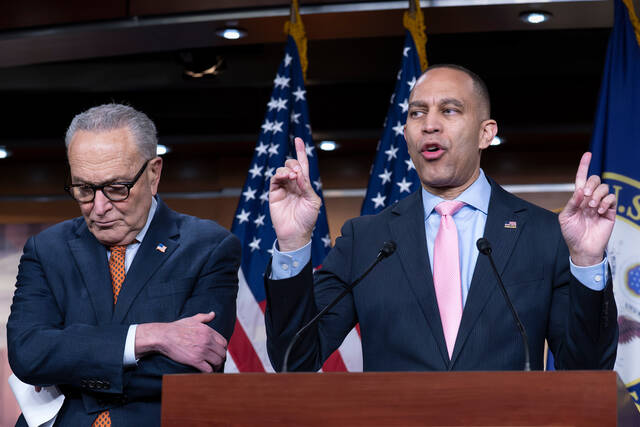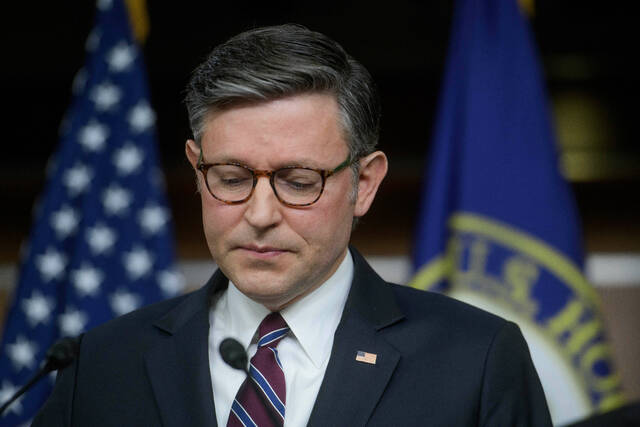Nearly a quarter of Pennsylvanians are on Medicaid, the joint federal-state program that covers medical costs for poor people along with nursing home and personal care home expenses. If Republicans on Capitol Hill target Medicaid as they seek to slash federal spending by $2 trillion and enact $4.5 trillion in tax cuts, the impact could be devastating. Medicaid, along with Medicare, a federal health insurance for those over 65, have long been considered sacrosanct programs.
President Trump has pledged not to cut them, but many lawmakers remain concerned about Medicaid’s future.
Below is a primer on Medicaid, why it is under fire and what could happen if it were cut.
What’s what?
Medicaid is a public health insurance program for low-income Americans that covers about one in five Americans.
States and the federal government share the cost — about $872 billion in 2023.
Medicaid is administered by each state with assistance from the Centers for Medicare & Medicaid Services, a part of the U.S. Department of Health and Human Services.
Also, facing possible cuts is CHIP, the Children’s Health Insurance Program, that provides health insurance to children who meet income requirements. It varies from state to state, but it also is under the auspices of CMS.
What could happen if Medicaid is cut?
The House committee that oversees Medicaid and Medicare has been tasked with producing $880 billion of the $2 trillion in spending cuts being sought, and experts have concluded there’s no way to achieve that goal without affecting Medicaid.
“People would lose their health care to give other people a tax break,” said Erin Guay, co-executive director of the Pennsylvania Health Law Project, an advocacy group with offices in Pittsburgh and Philadelphia that helps people navigate the intricacies of Medicaid.
Guay was among the people closely watching what’s unfolding in Washington as Congress works with the Trump administration on proposed cuts in federal spending.
“We’re not going to touch it,” Trump said of Medicaid, Medicare and Social Security on Wednesday, while promising a crackdown on fraud in the programs.
But the math points to cutting something from Medicaid, which along with Medicare and Social Security account for 75% of the government’s mandatory spending (that which is required by law).
Any cuts or changes to Medicaid eligibility would hurt millions of Pennsylvanians, Guay said.
“Medicaid is the last resort for many Americans to get medical treatment; it probably should be expanded. I don’t get it,” Pittsburgh elder law attorney Barbara Ernsberger said.
She represents people who need Medicaid to pay for their care in a nursing home or assisted living facility. She said she’d received several calls from clients concerned about the doings in Washington.
“I don’t know how to stop it. It’s just too harmful,” Ernsberger said. “There’s got to be better ways to reduce the budget.”
How much does it cost?
Medicare: $1.013 trillion; about $10,896 per enrollee
Medicaid: $872 billion
CHIP: $17.6 billion
Program management: $7.1 billion
CMS employed 6,609 people in 2023
Source: CMS/Office of Financial Management
How we got here
Social Security started 90 years ago as part of President Franklin Delano Roosevelt’s New Deal. It was initially a program that provided benefits to retirees but has since expanded to provide benefits to spouses and survivors (1939) and those with disabilities (1956).
Medicare and Medicaid are national health insurance programs started 60 years ago as part of President Lyndon B. Johnson’s Great Society plan that revised the Social Security Act.
“For a century we labored to settle and to subdue a continent. For half a century we called upon unbounded invention and untiring industry to create an order of plenty for all of our people.
“The challenge of the next half century is whether we have the wisdom to use that wealth to enrich and elevate our national life, and to advance the quality of our American civilization,” Johnson said in a May 22, 1964 speech at the University of Michigan that outlined the broad aims of his proposals.
The Great Society was the largest expansion of the welfare state since the New Deal in the 1930s.
What’s next
The House approved a budget resolution Tuesday that includes $4.5 trillion in tax cuts and a $2 trillion reduction in spending over the next decade.
Now, the details about what could be cut need to be worked out by Congress.
A poll released Monday found 70% opposed the elements of the House Republican budget bill that would: extend all tax cuts in the Trump tax law, including for the wealthy; add new tax cuts for corporations and the wealthy; add new tax cuts for tipped workers; and cut Medicaid, food stamps, and aid to the poor.
It was conducted Feb. 12 through 16 — before the bill passed — by Hart Research and surveyed a national cross-section of 1,011 voters.
Who gets hurt the most?
Nearly half — 87 — of the 189 residents of The Willows skilled nursing community in Oakmont use Medicaid as their source of funding, according to Presbyterian SeniorCare Network spokesman Jonathan Szish.
“Without that coverage, or with a reduction in coverage, older adults may not receive the care they need,” Szish said.
Making cuts to Medicaid would exacerbate preexisting funding issues highlighting in a 2022 study commissioned by LeadingAge PA.
The study found a $1.2 billion gap between reimbursement rates and the actual costs of care in nursing homes, said LeadingAge PA spokeswoman Katie Andreano.
“We believe that continued investment in Medicaid funding is necessary to keep nursing homes afloat,” she said.
Tom Davidson is a news editor and Jeff Himler is a TribLive staff writer. They can be reached at tdavidson@triblive.com and jhimler@triblive.com.











